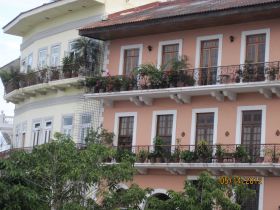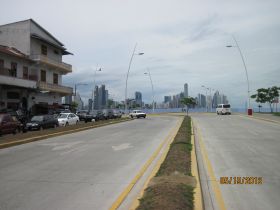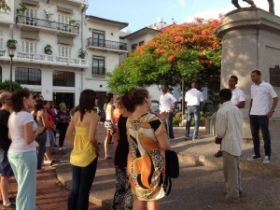What are the main cities, towns, communities and developments of the Panama City Casco Viejo area and what is each one like?
Lourdes Townshend
Casco Viejo is a charming place, inside the city of Panamá. It was appointed "Patrimony of the Humanity" (World Heritage Site) by the UNESCO a few years ago, for its unique historical and cultural monuments relating several centuries of participation by Panamá as a center for all kinds of cultural and trade paths and history that can still be seen today. There is also the phenomenon that Panamá is considered the number one...
Casco Viejo is a charming place, inside the city of Panamá. It was appointed "Patrimony of the Humanity" (World Heritage Site) by the UNESCO a few years ago, for its unique historical and cultural monuments relating several centuries of participation by Panamá as a center for all kinds of cultural and trade paths and history that can still be seen today. There is also the phenomenon that Panamá is considered the number one destination for many foreigners seeking a better life.
Casco Viejo is not divided into towns, cities, communities or developments. It is simply a place with narrow brick streets, lots of history, small arts & crafts stores, many cafes and restaurants, the Presidential Palace, government buildings, many old Catholic churches including St. Joseph (which has a real gold altar), some beautifuly renovated houses, and the "Bovedas" which is an antique fort for defense against the pirates, all of which is surrounded by a beautiful bay. Houses will be renovated little by little, but are protected by a special law of conservation.
Casco Viejo is not yet fully developed, and some old local residents still remain in the area, but visitors and future residents are looking into the Casco Viejo area more and more every day. It will soon also be surrounded by the new and final phase of the "cinta costera", which is a beautiful boulevard between the ocean and Casco Viejo, ending at the entrance to the Panamá Canal.
Posted January 5, 2014
Rey Bazán
(Casco Viejo and Casco Antiguo are  different names for the same place.)
different names for the same place.)
 different names for the same place.)
different names for the same place.) We do use street names in Casco Viejo / Casco Antiguo, but many times we give directions and locations via points of reference. For instance, we may say “it’s near the fish market” or “to the side of the plaza”; things that are more familiar.
Casco Viejo has three main areas.
Near the fish...
(Casco Viejo and Casco Antiguo are  different names for the same place.)
different names for the same place.)
 different names for the same place.)
different names for the same place.) We do use street names in Casco Viejo / Casco Antiguo, but many times we give directions and locations via points of reference. For instance, we may say “it’s near the fish market” or “to the side of the plaza”; things that are more familiar.
Casco Viejo has three main areas.
Near the fish market is the area where you also have close by Panama's Chinatown of the late 1800s and 1900s. Today, there are Chinese there who sell food and merchandise. That area is called Terra Plene. This is a colorful neighborhood, where you can get almost anything. You’ll see peddlers on the street.
The fish market is very popular with Americans. You can buy excellent fish at reasonable prices. At the fish market there are restaurants, including a restaurant upstairs. You have also outdoors tables where you buy ceviche and other seafood and you eat it there or you take it home.
 The fish market area is growing because they’ve just expanded the coastal beltway that goes around the water and the fish market is roughly in the middle of the coastal beltway. This area is popular, but its more low key. The buildings aren’t that new, but there’s potential. Lots of people go shopping at the fish market, not only for fish, but for other items, including Chinese tea, herbs, and other products they have from China. You can also have a Chinese breakfast there.
The fish market area is growing because they’ve just expanded the coastal beltway that goes around the water and the fish market is roughly in the middle of the coastal beltway. This area is popular, but its more low key. The buildings aren’t that new, but there’s potential. Lots of people go shopping at the fish market, not only for fish, but for other items, including Chinese tea, herbs, and other products they have from China. You can also have a Chinese breakfast there. The fish market area also has some fantastic buildings that face the water. These buildings have a lot of potential because not only are you in Casco Antiguo, but you also have a fabulous view of the modern part of Panama City.
Another area of Casco Antiguo is called Santa Ana. Santa Ana is an old place with a small plaza and a church. There are many pedestrians. Santa Ana is where the city started to grow from the core of Casco Antiguo / Casco Viejo.
Posted August 3, 2014
Patrizia Pinzon - Arco Properties
 In 1997 Casco Viejo became a UNESCO World Heritage Site. There are actually three neighborhoods comprising what most people consider Casco Viejo. (Esperanza Tour at Fortalez, pictured.)
In 1997 Casco Viejo became a UNESCO World Heritage Site. There are actually three neighborhoods comprising what most people consider Casco Viejo. (Esperanza Tour at Fortalez, pictured.) - San Felipe used to be the walled city. The wall didn’t last long because they needed the stones to build more houses as the population boomed in Colombia during colonial times. [Editor's note: Panama was part of Columbia at one time.] As a result, you’ll see...
 In 1997 Casco Viejo became a UNESCO World Heritage Site. There are actually three neighborhoods comprising what most people consider Casco Viejo. (Esperanza Tour at Fortalez, pictured.)
In 1997 Casco Viejo became a UNESCO World Heritage Site. There are actually three neighborhoods comprising what most people consider Casco Viejo. (Esperanza Tour at Fortalez, pictured.) - San Felipe used to be the walled city. The wall didn’t last long because they needed the stones to build more houses as the population boomed in Colombia during colonial times. [Editor's note: Panama was part of Columbia at one time.] As a result, you’ll see a lot of old stones used inside the houses.
San Felipe is the most developed area around Casco Viejo. In the general, in Casco Viejo area, San Felipe was the first neighborhood to get restored, and it has the majority of the restoration completed. It would have a higher percentage of the restored buildings, as opposed to the ones that are not yet restored. As a result, it’s the higher- end area by definition. They are still restoring some of it. The wave goes where the waves can find properties and its economic path.
- Santa Ana is just outside the walled area of San Felipe. Santa Ana is starting to be restored. Central Avenue (which is part of Santa Ana) is kind of like the commercial artery, both in the past, and now. It’s always buzzing with people going in and out with packages and street vendors. It has a very local and colorful vibe to it.
Central Avenue is part of Santa Ana. Somehow in the Panama, the way of calling places, it stands on its own, but it’s not a neighborhood.
I believe that Central Avenue is the only pedestrian street in Panama City. It has very, very local commerce, so if you go there, you see street vendors, food and clothing and it is always packed with people coming in and going. There are no cars allowed on Central Avenue.
- As you come into Casco Viejo, El Terraplan is the first area that you see to your left. It is the curved street. El Terraplan is the waterfront area and it connects San Felipe with the modern side of Panama City towards Balboa Avenue and the first section of the Cinta Costera. It’s that space in the middle. It has a different name because it was Panama’s first landfill in the 20s, so it didn’t exist in colonial times.
El Terraplen has a very vibrant fish market and it is interesting to see how it is evolving, and it is starting to be restored, little by little.
Also little by little, the fish market has turned into this attraction, and there are all these little restaurants that have opened there. It’s very interesting because it’s very local and the fish is great. You can actually go into the fish market, buy a bunch of fish, take it to the restaurant upstairs and they’ll cook it for you. Everyone has fun and enjoys that.
Posted January 22, 2015


